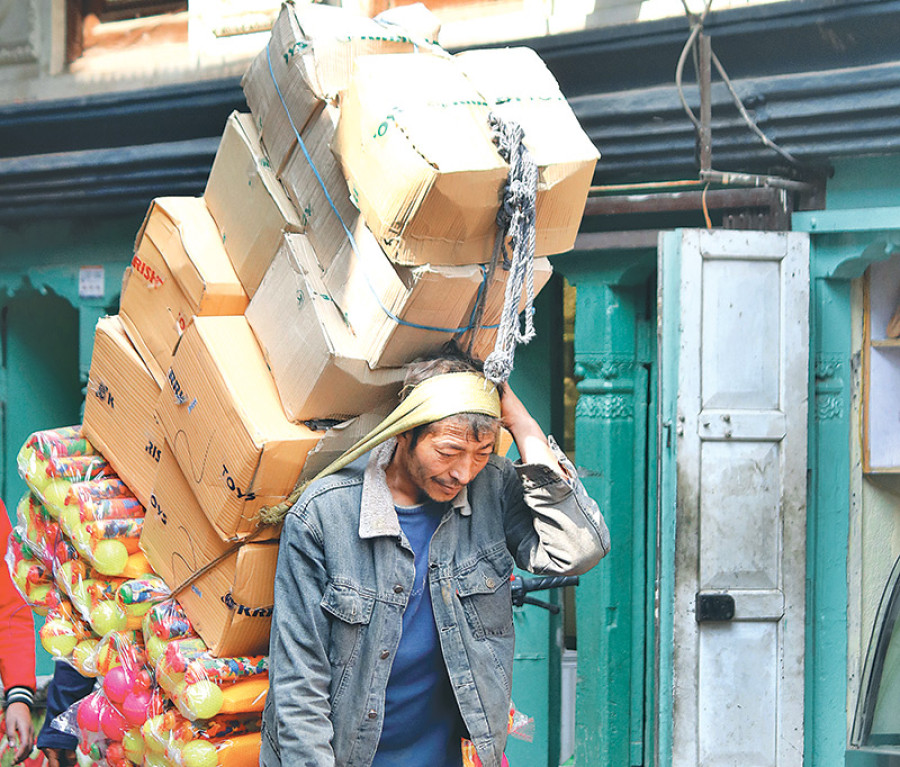Miscellaneous
Best foot forward
51-year-old Ram Bahadur Thapa, a porter by trade, had become anxious in the last few years because of a rapid decline in work opportunities in the Capital.
Abijeet Pant
51-year-old Ram Bahadur Thapa, a porter by trade, had become anxious in the last few years because of a rapid decline in work opportunities in the Capital. Furthermore, when the earthquakes destroyed his home, he grew increasingly anxious as he knew his financial prospects in the near future were also grim.
“I have been a porter for the last 25 years. I come to Kathmandu every year from my village in Okhaldhunga during ‘peak seasons’ to make a living,” Thapa shared, “but during the last few years, I barely managed to make enough to survive in the city.”
Thankfully, the question of survival no longer looms large for Thapa and porters like him with work prospects booming since the Kathmandu Metropolitan City(KMC) declared Asan, Thamel, Mahaboudha, and several core streets of Kathamndu as ‘vehicle free zones’ last year.
According to Thapa, who is normally stationed at Mahaboudha, carrying loads in the Capital is seasonal work, which reaches its peak right before festivities such as Dashain and Loshar. Now that the festivities have ended, peak season is coming to a close, and Thapa is getting ready to head back to Okhaldhunga. “This has been the best season in years. I will be taking home about Rs 20,000,” Thapa shared, “I have enough to start rebuilding my house and to continue farming.”
These days, porters carrying goods in Asan and Thamel are as common as the tourists who are leisurely strolling through the old neighbourhoods of Kathmandu. When ten different kinds of stores were surveyed in Thamel and Asan, seven of the shopkeepers shared that they had switched to employing porters instead of motor vehicles for transportation of goods, while three reported they had just found ways to work around the 12 hour vehicular ban (7am-7pm). Similarly, when porters at Mahaboudha were asked if they had felt any significant changes in their earning, half of them admitted that their earnings had grown in the past season, while rest of them shared that it had remained about the same.
“On the surface, it would seem that our work has greatly increased with the ban,” Kumar Khatri, another porter based out of Mahaboudha, shared, “But still, when there are over 500 of us waiting for cargo vehicles to arrive, it is very competitive. Not everyone may feel the increase in work and pay.” Khatri also points out that many streets around Asan were already so narrow that porters had always been the go-to choice for transport, “However, now that the cars are gone, the streets are much easier to walk through,” he said, “This means we can do many more ‘trips’ throughout the day.”

It might not be an astronomical growth, according to Thapa, but there has been a marked increase of Rs 200-300 everyday, which is encouraging for people like him who were contemplating going to India in search of seasonal work. Instead, he will be making his way back to the Capital when the next ‘season’ arrives.
The vehicle free zone has provided an economic lifeline to porters and has made Asan’s streets markedly more walkable, however, the move was not initially welcomed by businessowners in the area. “Many of the shop owners had complained that there would be difficulty in transporting goods and a decline in tourists,” Gyanendra Karki, spokesperson for KMC shared, “Now, we sense a change in heart; everyone is seeing and enjoying the benefits of creating vehicle free zones in the city. We hope to replicate the initiative in other areas in the coming year.”
Sanjaya Shakya, a grocer based in Asan, was one of the people who were initially resistant to the idea of the vehicle free zone, but now he has become accustomed to using porters to transport goods during the day, “I thought that I would lose business,” said Shakya, “But now because of the increase in people strolling through the market place, there has been an increase in footfall at my shop.”
Instead of vans blocking the traffic to load and unload goods, today one can see an increased number of porters sweating beads as they carry goods through the streets. According to Thapa and Khatri, a porter’s wage depends mostly on two factors: the weight of the cargo and the transportation distance. Typical weights range from about 50 kilos to 200 kilos and typical distances range from Asan to as far as Thamel. “Considering both of these factors, a porter can expect to earn about Rs 150 per trip on average,” they shared, “Our actual wages can range from Rs 50 to Rs 300 for a single trip.”

On a good day, the porters share, they earn as much as Rs 1,000. “About half of our daily wage is used for meals and other expenses associated with living in the city,” Thapa said, “But for the first time in a while, things are looking up for us. When the vehicle ban was introduced, we probably never factored in on the equation. But we are more than happy to reap the benefits. Many of us can now afford to stick around all year, instead of just during the ‘peak seasons’.”




 14.12°C Kathmandu
14.12°C Kathmandu










